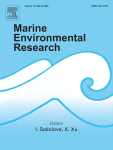The Little Neptune grass Cymodocea nodosa is a key seagrass species in the Mediterranean Sea, forming extensive and patchy meadows in shallow coastal and transitional ecosystems. In such habitats, high temperatures and salinities, separately and in combination, can be significant stressors in the context of climate change, particularly during heatwave events, and seawater desalination plant effluents.
Despite well-documented negative, macroscopic effects, the underlying cellular and molecular processes of the combined effects of increasing temperature and salinities have remained largely elusive in C. nodosa – which are addressed by the present study. High salinity and high temperature, alone and in combination, affected ion equilibrium in the plant cells. Non-synonymous mutations marked the transcriptomic response to salinity and temperature stress at loci related to osmotic stress. Cell structure, especially the nucleus, chloroplasts, mitochondria and organization of the MT cytoskeleton, was also altered. Both temperature and salinity stress negatively affected photosynthetic activity as evidenced by ΔF/Fm’, following an antagonistic interaction type.
Overall, this study showed that all biological levels investigated were strongly affected by temperature and salinity stress, however, with the latter having more severe effects. The results have implications for the operation of desalination plants and for assessing the impacts of marine heat waves.

